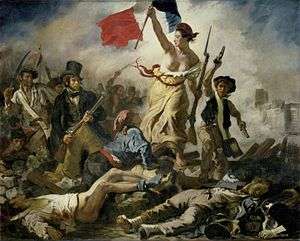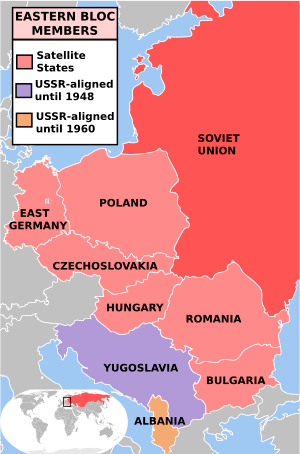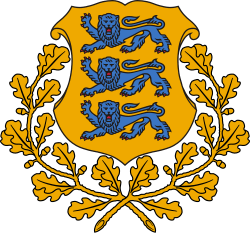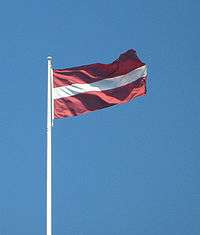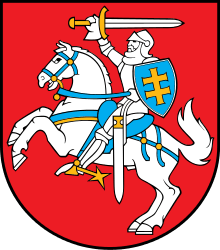Singing Revolution
The Singing Revolution is a commonly used name for events between 1987 and 1991 that led to the restoration of the independence of Estonia, Latvia and Lithuania.[1][2] The term was coined by an Estonian activist and artist, Heinz Valk, in an article published a week after the 10–11 June 1988, spontaneous mass night-singing demonstrations at the Tallinn Song Festival Grounds.[3]
Background
After World War II, the Baltic states had been fully incorporated into the USSR after military occupation and annexation first in 1940 and then again in 1944. Mikhail Gorbachev introduced "glasnost" (openness) and "perestroika" (restructuring) in 1985, hoping to stimulate the failing Soviet economy and encourage productivity, particularly in the areas of consumer goods, the liberalisation of cooperative businesses and the service economy. Glasnost rescinded limitations on political freedoms in the Soviet Union which led to problems within the non-Russian nations occupied in the build-up to war in the 1940s.
Hitherto unrecognised issues previously kept secret by the Moscow government were admitted to in public, causing dissatisfaction within the Baltic states. Combined with the war in Afghanistan and the nuclear fallout in Chernobyl, grievances were aired in a publicly explosive and politically decisive manner. Estonians were concerned about the demographic threat to their national identity posed by the influx of individuals from foreign ethnic groups to work on such large Soviet development projects as phosphate mining.[4]
Access to Western émigré communities abroad and, particularly in Estonia, informal relations with Finland and access to Finnish TV showing the Western lifestyle also contributed to widespread dissatisfaction with the Soviet system and provoked mass demonstrations as repression on dissidents, nationalists, religious communities and ordinary consumers eased substantially towards the end of the 1980s.
Massive demonstrations against the Soviet regime began after widespread liberalisation of the regime failed to take into account national sensitivities. It was hoped by Moscow that the non-Russian nations would remain within the USSR despite the removal of restrictions on freedom of speech and national icons (such as the local pre-1940 flags). However, the situation deteriorated to such an extent that by 1989 there were campaigns aimed at freeing the nations from the Soviet Union altogether.
Estonia
The Soviet government's plan to excavate phosphorite in the Lääne-Viru County with potentially catastrophic consequences for the environment and the society was revealed in February 1987. That started the Phosphorite War public environmental campaign.[5] The MRP-AEG group held the Hirvepark meeting in the Old Town of Tallinn at the anniversary of Molotov–Ribbentrop Pact on 23 August 1987, demanding to disclose and condemn its secret protocol.
The "Five Patriotic Songs" series by Alo Mattiisen premiered at the Tartu Pop Festival in May 1988.[6] In June the Old Town Festival was held in Tallinn, and after the official part of the festival, the participants moved to the Song Festival Grounds and started to sing patriotic songs together spontaneously.[7] The Baltic Way, a human chain of two million people spanned from Tallinn to Vilnius on 23 August 1989.[8] Mattiisen's "Five Patriotic Songs" were performed again at the Rock Summer festival in Tallinn held on 26–28 August 1988.[9] The Song of Estonia festival was held at the Song Festival Grounds on 11 September.[6] Trivimi Velliste, Chairman of the Estonian Heritage Society first voiced the public ambition to regain independence.[10] The Supreme Soviet of Estonia issued the Estonian Sovereignty Declaration on 16 November.[8]
The Singing Revolution lasted over four years, with various protests and acts of defiance. In 1991, as Soviet tanks attempted to stop the progress towards independence, the Supreme Soviet of Estonia together with the Congress of Estonia proclaimed the restoration of the independent state of Estonia and repudiated Soviet legislation. People acted as human shields to protect radio and TV stations from the Soviet tanks. Through these actions Estonia regained its independence without any bloodshed.[11]
Independence was declared on the late evening of 20 August 1991, after an agreement between different political parties was reached. The next morning Soviet troops, according to Estonian TV, attempted to storm Tallinn TV Tower but were unsuccessful.[12] The Communist hardliners' coup attempt failed amidst mass pro-democracy demonstrations in Moscow led by Boris Yeltsin.
On 22 August 1991, Iceland became the first nation to recognise the newly restored independence of Estonia. Today, a plaque commemorating this event is situated on the outside wall of the Foreign Ministry, which itself is situated on Islandi väljak 1, or "Iceland Square 1". The plaque reads; "The Republic of Iceland was the first to recognise, on 22 August 1991, the restoration of the independence of the Republic of Estonia", in Estonian, Icelandic and English. Some other nations did not recognise the annexation of Estonia by the Soviet Union.[13][14]
Latvia
During the second half of the 1980s as Mikhail Gorbachev introduced glasnost and perestroika in the USSR, which rolled back restrictions to freedom in the Soviet Union, aversion to the Soviet regime had grown into the third Latvian National Awakening, which reached its peak in mid-1988.
In 1986, it became widely known to the public that the USSR was planning to build another hydroelectric power plant on Latvia's largest river Daugava, and that a decision had been made to build a metro in Riga. Both of these projects planned by Moscow could have led to the destruction of Latvia's landscape and cultural and historical heritage. In the press journalists urged the public to protest against these decisions. The public reacted immediately, and in response the Environmental Protection Club was founded on 28 February 1987. During the second half of the 1980s the Environmental Protection Club became one of the most influential mass movements in the region and began to make demands for the restoration of Latvia's independence.
On 14 June 1987, the anniversary of the 1941 deportations, the human rights group "Helsinki-86", which had been founded a year earlier, organised people to place flowers at the Freedom Monument (Latvia's symbol of independence, which was erected in 1935). This is widely cited as the beginning of the National Awakening. However the Latvian Song and Dance Festival of 1985 also had been sometimes named for choirs requesting and performing the song Gaismas pils conducted by Haralds Mednis after the main event. The song, which speaks about the rebirth of a free Latvian nation, usually a staple of the festival, had been removed from the repertoire and the conductor, disliked by Soviet authorities, sidelined.[15]
On 1 and 2 June 1988, the Writers' Union held a congress during which the democratisation of society, Latvia's economic sovereignty, the cessation of immigration from the USSR, the transformation of industry and the protection of Latvian language rights were discussed by delegates. Over the course of this conference, for the first time in post-war Latvia, the secret protocol of the Molotov–Ribbentrop Pact, which had determined Latvia's fate after 1939, was publicly acknowledged.
The congress of the Writers' Union stirred up public opinion and provided an additional stimulus for the general process of national revival.
In the summer of 1988, two of the most important organisations of the revival period began to assemble themselves—the Latvian People's Front and the Latvian National Independence Movement (LNIM). Soon afterwards the more radically inclined Citizens' Congress called for complete non-compliance with the representatives of the Soviet regime. All of these organisations had a common goal: the restoration of democracy and independence. On 7 October 1988, there was a mass public demonstration, calling for Latvia's independence and the establishment of regular judicial order. On 8 and 9 October the first congress of the Latvian People's Front was held. This organisation, which attracted 200,000 members, became the main representative of the return to independence.
On 23 August 1989, the fiftieth anniversary of the Molotov–Ribbentrop Pact, the People's Fronts of all three Baltic countries held a huge demonstration of unity—the "Baltic Way". A 600 km (373 mi) long human "chain" from Tallinn through Riga to Vilnius was assembled. This was a symbolic demonstration of the people's call for independence from the Soviet Union.
New elections to the Supreme Soviet took place on 18 March 1990, in which the supporters of independence gained a victory. On 4 May 1990, the new Supreme Soviet of the Latvian SSR adopted a motion, "Declaration of Independence", which called for the restoration of the inter-war Latvian state and the 1922 Constitution.
In January 1991, however, pro-communist political forces attempted to restore Soviet power. With the use of force, attempts were made to overthrow the new assembly. Latvian demonstrators managed to stop the Soviet troops from re-occupying strategic positions, and these events are known as the "Days of the Barricades".
On 19 August 1991, an unsuccessful attempt at a coup d'état took place in Moscow when a small group of prominent Soviet functionaries failed to regain power due to large pro-democracy demonstrations in Russia. This event resulted in Latvia swiftly moving toward independence. After the coup's failure the Supreme Soviet of the Latvian Republic announced on 21 August 1991, that the transition period to full independence declared on 4 May 1990 had come to an end. Therefore, Latvia was proclaimed a fully independent nation whose judicial foundation stemmed back to the statehood that existed before the occupation on 17 June 1940.
Notable protest songs
- "Brīvību Baltijai"[16]
- "Dzimtā valoda"[16]
- Lāčplēsis
- "Manai Tautai"[16]
- "Pūt, Vējiņi!" – Latvian version of a Livonian wedding folk song ("Pūgõ tūļ") and often used in place of the national anthem during the Soviet era.[17]
- "Ei ole üksi ükski maa"[16]
- "Eestlane olen ja eestlaseks jään"[16]
- "Isamaa ilu hoieldes"[16]
- "Sind surmani"[16]
- "Mingem üles mägedele"[16]
Lithuania
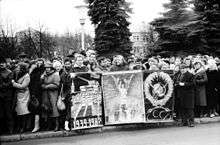
Thousands of people regularly gathered in public places across Lithuania and sang national songs and Roman Catholic hymns. The popularity of patriotic songs had risen significantly during this period. Many popular singers had followed this trend, often using the poetry of nationalist poets, such as Bernardas Brazdžionis or Justinas Marcinkevičius as the lyrics of their songs. Rock March also promoted awareness of the issue among the people.
On 3 June 1988, the Sąjūdis, a political and social movement to lead the independence and pro-democracy movement, was established.
The active nationalist opposition towards the regime culminated in the return of Vilnius Cathedral, formerly used as a museum of fine arts, to the Catholic community on 21 October 1988, followed by the gradual restoration of national symbols, which included the erection or restoration of independence monuments throughout the country. The national anthem of Lithuania and the traditional national Tricolore were legalised in Lithuania on 18 November 1988, officially replacing the flag and the anthem of the Lithuanian Soviet Socialist Republic.
Five decades after Lithuania was occupied and incorporated into the Soviet Union, Lithuania became the first republic to declare its independence from the USSR on 11 March 1990, and was later followed by Latvia and Estonia. However, almost all nations in the international community, except Iceland, hesitated to recognise independence for Lithuania until August 1991.
The Soviet military responded harshly. On 13 January 1991, fourteen non-violent protesters in Vilnius died and hundreds were injured defending the Vilnius Television Tower and the Parliament from Soviet assault troops and tanks. Lithuanians referred to the event as Bloody Sunday. The discipline and courage of its citizens—linking arms and singing in the face of tanks and armour-piercing bullets—avoided a much greater loss of life and showed the world that Lithuania's citizens were prepared to defend national independence.
The international governments recognised Lithuanian independence after the failure of the coup d'état in August 1991.
See also
Notes and references
- ↑
- Thomson, Clare (1992). The Singing Revolution: A Political Journey through the Baltic States. London: Joseph. ISBN 0-7181-3459-1.
- ↑ Ginkel, John (September 2002). "Identity Construction in Latvia's "Singing Revolution": Why inter-ethnic conflict failed to occur". Nationalities Papers. 30 (3): 403–433. doi:10.1080/0090599022000011697.
- ↑ Between Utopia and Disillusionment By Henri Vogt; p 26 ISBN 1-57181-895-2
- ↑ Estonia and the Estonians, Toivo U. Raun, Hoover Press, 2001, p. 223
- ↑ Phosphorite War Estonica. Ecyclopaedia about Estonia
- 1 2 "Estonica.org - The Singing Revolution". www.estonica.org. Retrieved 2018-04-19.
- ↑ "10th June 1988 – the Singing Revolution". Dorian Cope presents On This Deity. Retrieved 2018-04-19.
- 1 2 "Estonia's Singing Revolution (1986-1991) | ICNC". ICNC. 2016-02-25. Retrieved 2018-04-19.
- ↑ "1988 – Rock Summer I - Rock Summer". www.rocksummer.ee. Retrieved 2018-04-19.
- ↑ "Estonica.org - Song of Estonia". www.estonica.org. Retrieved 2016-02-15.
- ↑ State of World Liberty Archived 2010-09-30 at the Wayback Machine.
- ↑ History of ETV (in Estonian) Archived 2008-02-14 at the Wayback Machine.
- ↑ Chen, Ti-Chiang Chen (1951). The international law of recognition. Рипол Классик. p. 157. ISBN 9785875231827.
- ↑ Toomas Hendrik Ilves. "President of the Republic at the State Dinner hosted by President T. E. Mary McAleese and Dr. Martin McAleese, Dublin, Republic of Ireland, 14 April 2008". President Republic of Estonia. Estonia. Archived from the original on 23 December 2015. Retrieved 20 April 2015.
The President of Estonia Toomas Hendrik Ilves said: "... ... we are thankful that Ireland never recognised the illegal annexation of Estonia by the Soviet Union after the Second World War. We will never forget John McEvoy, Estonia’s honorary consul in Dublin from 1938 to 1960.
- ↑ "JĀZEPS VĪTOLS'S "GAISMAS PILS": a ballad for mixed choir". Latvian Cultural Canon. Archived from the original on 18 March 2013. Retrieved 28 March 2013.
- 1 2 3 4 5 6 7 8 "Latvijas neatkarības atjaunošana" (in Latvian). Archived from the original on 22 May 2013. Retrieved 29 March 2013.
- ↑ Latkovskis, Bens. "'Pūt, vējiņi' – tautas himna vai dzērāju dziesma?" (in Latvian). Delfi. Retrieved 29 March 2013.
External links
| Wikimedia Commons has media related to Singing Revolution. |
- A Lithuanian history, including information about Bloody Sunday
- Tallinn-Life: A Brief Guide to the Estonian Singing Revolution
- Aadu Jogiaas: Disturbing soviet transmissions in August 1991 Museum of Occupations
- The Singing Revolution, US documentary film of the Estonian Singing Revolution
- General information about The Singing Revolution
- Washington Newsletter - When Songs Trumped Rifles
- Singing Revolution Cantata performance at UIC pavilion, Chicago, IL, Summer, 2015
